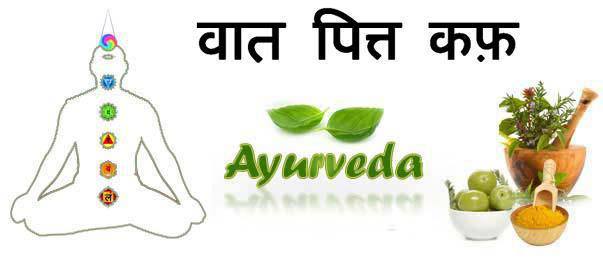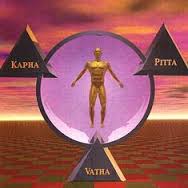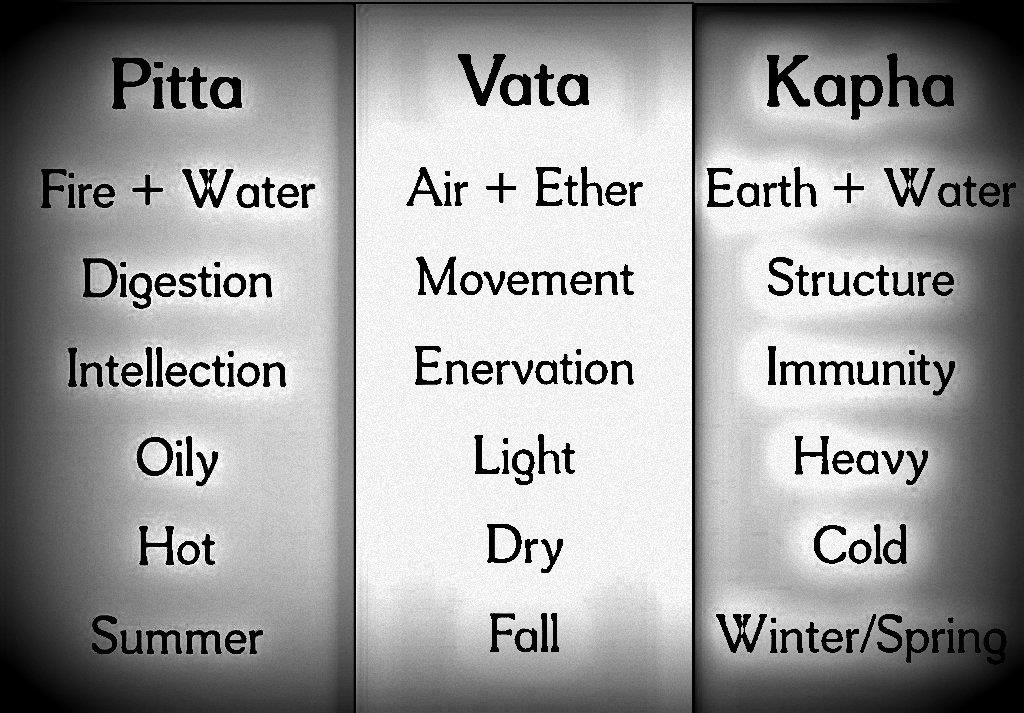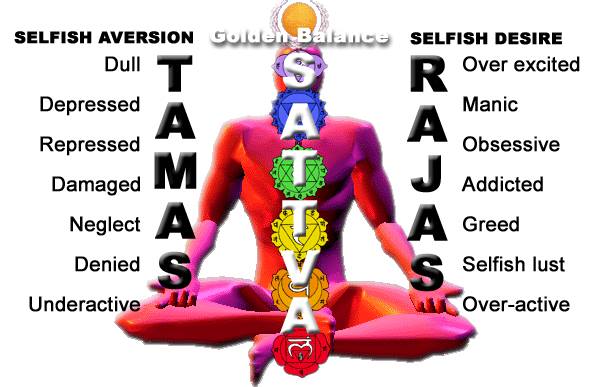Are you Pitta Vata or KaphaText by Ayurveda dr. Updesh Rajariya 
Prakriti :-prakriti is your basic constitution. It is determined at the moment of conception and relates to your genetically inherited physical and emotional qualities. Prakriti specifically relates to Prakrti and Vikrti If the current proportion of our doshas differs significantly from our constitutional proportion, it indicates imbalances, which in turn can lead to illness. This deviation from prakrti is called Vikrti. The farther a person's vikrti is from his or her prakrti, the more prone to illness they are. The concept of prakrti and vikrti can be illustrated with reference to the body's temperature. When healthy, we maintain an average body temperature of about 98* F. Although different persons can have different base temperatures, it does not change much so long as the person is healthy. When we go outside on a winter day, our body temperature may go down slightly but will pick right back up to the normal if we are healthy. Similarly, jogging on a hot day can temporarily raise our body temperature. When we are sick, or catch a cold, our body temperature will go up. This indicates that we are sick or outside our normal base condition. Our present temperature may be considered as Vikrti and the difference between the Prakrti (our normal temperature) and Vikrti (our present temperature) can determine whether any medical intervention is required. Prakrti, the Three Doshas and The Three Gunas The three doshas, Vaata, Pitta and Kapha are composed of the five basic elements. On the other hand, the five elements possess one or more of the three gunas, namely Satva, Rajas and Tamas. According to Susruta Samhita, Aakaasa is predominant of Satva guna while Vaayu is predominant of Rajas. Agni is predominant of Satva and Rajas while Jala is predominant of Satva and Tamas. Prthvi is predominantly Taamasic.
Dosha Basic Elements Predominant Guna VAATA Vaayu, Aakaasa Rajas PITTA Agni, Jala Satva KAPHA Prthvi, Jala Tamas As the entire universe is paancabhautika (comprised of five elements) in nature, the food one eats and the activities one performs have a profound impact on the proportions of the three doshas, and hence the five elements in the body. To put it more simply: “You are what you eat .“ Types of Prakrti Basically, Prakrti has been classified into two as 1. Saareerika - bodily and 2. Maanaseeka – mental Based on the three doshas and their physical and physiological qualities, the Saaeerika Prakrti has been classified into seven namely 1. Vaata 2. Pitta 3. Kapha 4. Vaata – Pitta 5. Pitta – Kapha 6. Kapha – Vaata and 7. Tridoshaja or Sannipaata Based on the three gunas and their emotional, behavioral, cognitive and mental abilities and qualities, the Maanaseeka Prakrti has been classified into three namely 1. Saatvika 2. Rajasiaka and 3. taamasika In order to understand a person, it is necessary to first determine his or her prakrti. By understanding the prakrti of a person, a vaidya, or doctor, is able to detect the changes in the prakrti of the person. Using prakrti as the base, he then diagnoses the disease. Irrespective of whether a person is healthy or ill, knowing one's prakrti helps one to know oneself better and live a healthy and peaceful life. The following table contains the characteristics of the different types of prakrtis. Physical Traits TRAIT VAATA PITTA KAPHA Body frame thin medium hefty Finger nails cracking and thin pink and soft wide, white and thick Hair thin and dry grey and bald silky, curly and dense Resting pulse (early morning or before breakfast) 80 - 100 70 - 80 60 - 70 Weight low and bony medium and muscular often overweight Bowel movements small, hard, with gas, frequently constipated loose and burning moderate and solid Forehead size small medium, large Appetite irregular strong and sharp constant and poor Eyes small and unsteady reddish and cat eyed wide with large white part (sclera) Lips thin and crackin medium and soft large and smooth Skin Dry cherished and wrinkles oily and smooth Voice stammering and weak commanding and sharp soft, sweet and resonating Which most bothers you ? cold and dry heat and sun cold and damp Mental Traits TRAIT VAATA PITTA KAPHA Temperament nervous or fearful irritable or impatient easygoing Speech quick or talkative moderate or argues slow or silent Sleep pattern less and disturbed moderate sleepy and lazy Habit travel sports or politics enjoying water and flowers Memory quickly grasps, soon forgets sharp and clear slow to learn, never to forget Beliefs radical or changing leader and goal oriented loyal and constant Dream flying and anxious fighting and colourful few and romantic Emotion enthusiastic but full of worries warm and angry calm and attached Mind quick and adaptable penetrating and critical slow and lethargic It is very rare to find an Eka prakrti – person predominant of only one dosha like kevala vaata prakrti. Most of us are Dvandva or Dvidoshaja or dual prakrtis like Vaata – pitta, Pitta – kapha or Vaata – kapha. A person with all the three doshas in equal proportion is called Samadosha or tridoshaja prakrti. The type of food one eats increases or decreases the corresponding type of dosha in the body. One's activities also have a similar effect. For instance, vaata prakrti persons intaking more vaata predominant foods are likely to suffer disorders of vaata origin. By making eating choices in harmony with one's Prakrti needs, one can lead a healthy life. Vata Light build Naturally creative Sensitive Prefer warm, humid climates Dry skin Pitta Medium, muscular build Productive, hard-working Irritable Prefer cold climates Fair skin Kapha Heavy build Stable, methodical Easy-going Prefer warm, dry climates Oily skin Some points to balancing vata pitta kapha :------ Balancing vata "When vata is aggravated, your system becomes irregular and depleted, which affects weak organs and tissues" Additional signs of vata imbalance: Constipation Dehydration Anxious Craving warmth Frequent viral infection Weight loss Disturbed sleep ---Excessive consumption of bitter, astringent and spicy tastes contribute to vata imbalance. Ayurveda recommends pacifying with sweet, sour and salty tastes and warm, moist, easily digestible foods like: Boiled or steamed starchy vegetables (moderate broccoli, cauliflower, zucchini and leafy vegetables) Ripe fruits Warm milk (moderate dairy) Soupy grains: rice, wheat Mild spices: cumin, ginger, cardamom, cinnamon, fennel, coriander, salt, cloves, mustard, black pepper Tea: camomile, fennel, ginger, liquorice, lemon "Nourishing soups, casseroles and dahls are great for balancing Balancing pitta "When pitta is unbalanced, you can become aggressive and irritable. Additional signs of imbalance: Diarrhoea Over-heating, profuse sweating Colourful, violent dreams Excessive hunger Frequent bacterial infections Heartburn Dr Prasad believes pitta imbalance may result from excessive alcohol or hot, spicy, oily, fried, salty, fermented foods. He suggests rebalancing with sweet, bitter and astringent tastes and cool, heavy foods including: Boiled, steamed, raw vegetables Sweet fruits Moderate amounts of dairy Soupy grains: rice, wheat, barley, oats Mild, cooling spices: coriander, cardamom, cloves, turmeric, cumin, curry leaves, mint Tea: fennel, camomile, peppermint, spearmint, liquorice, red clover Balancing kapha "When kapha is unbalanced, there is a tendency for mental and physical stagnation. Stimulation of all kinds helps to avoid that heavy, lethargic feeling, Additional signs of imbalance: Sluggish bowels Procrastination Craving warmth, spicy foods Frequent candida infection Water retention Weight gain Excessive sleep advises excessive food consumption can contribute to kapha imbalance, and recommends a light, warm, low-fat diet of pungent, bitter and astringent tastes like: Boiled, steamed, raw vegetables Ripe fruits (except banana) Fat-free buttermilk (other dairy reduced) Grains: corn, millet, rye, oats, barley, wheatbran Strong spices: pepper, paprika, salt, garlic, basil, cloves, allspice, fennel, mustard, turmeric, cumin, ginger, cardamom, cinnamon, coriander, black pepper Honey instead of sugar Tea: cinnamon, fenugreek, peppermint, raspberry In the wise world of Ayurveda, you really are what you eat; so discover and dine for your dosha to restore holistic health of hips, head and heart. For example, if you have a predominance of Vata in your nature (cold, dry skin, restlessness, worry, light sleep etc), keep Vata in balance by favouring warm, moist, oily, heavy, sweet, sour and salty foods and by reducing cold, dry, light, pungent, bitter and astringent foods. The Six Tastes SWEET – Rice SALTY – Salt ASTRINGENT - Dal BITTER – Greens SOUR – Lemon PUNGENT - Hingu |
Kvantti Antti Tmi
- auttaa kivuissa ja kolotuksissa!
- soita ja varaa aika 044 0968 682
- auttaa kivuissa ja kolotuksissa!
- soita ja varaa aika 044 0968 682


 itta predominant, Pitta-Kapha predominant and
itta predominant, Pitta-Kapha predominant and 
